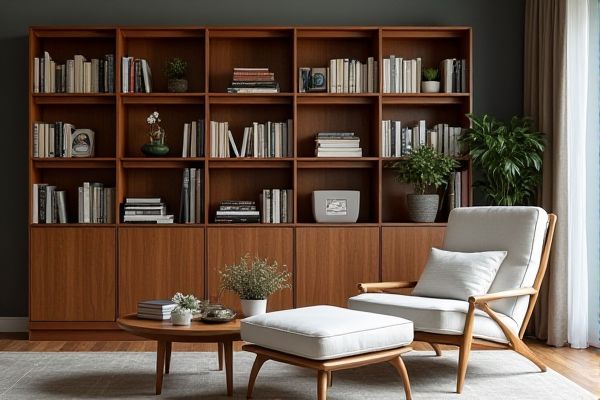
Built-in bookcases offer a seamless, custom look that maximizes space and integrates directly with your home's architecture, while freestanding bookcases provide flexibility and portability to easily change your room layout or relocate. Discover which option best suits Your needs by exploring the key differences, benefits, and design considerations in the rest of this article.
Table of Comparison
| Feature | Built-in Bookcase | Freestanding Bookcase |
|---|---|---|
| Installation | Permanent, fixed to walls | Portable, easy to move |
| Customization | Highly customizable to room dimensions | Limited sizes and designs |
| Space Utilization | Maximizes space use, built around architecture | Occupies floor space, less efficient |
| Cost | Higher initial investment, long-lasting value | Generally affordable, varies by material |
| Design Impact | Seamless integration with room decor | Can be a statement piece, easy to replace |
| Maintenance | Requires professional repairs | Easy to maintain and move for cleaning |
Introduction: Comparing Built-in and Freestanding Bookcases
Built-in bookcases maximize space by seamlessly integrating with your walls, offering a custom, permanent storage solution ideal for unifying room design and increasing home value. Freestanding bookcases provide flexibility with easy relocation and a variety of styles, making them perfect for renters or those who frequently redecorate. Choosing between built-in and freestanding depends on your space preferences, budget, and long-term storage needs.
Space Efficiency: Maximizing Room Layout
Built-in bookcases maximize space efficiency by fitting seamlessly into wall recesses, utilizing vertical room height without encroaching on floor area, which optimizes room layout and flow. Freestanding bookcases offer flexibility in placement but occupy more floor space, potentially limiting options for furniture arrangement. Choosing built-ins enhances storage capacity while maintaining open floor plans, ideal for smaller rooms or complex layouts.
Design Flexibility and Customization
Built-in bookcases offer exceptional design flexibility and customization by seamlessly integrating into existing walls, allowing for tailored dimensions, materials, and finishes that match architectural details and maximize space efficiency. Freestanding bookcases provide versatility in placement and style changes, enabling easy relocation and adaptability to evolving decor preferences without permanent modifications. Choosing between the two depends on the desired balance between permanent, bespoke installations and movable, modular storage solutions.
Installation Process and Requirements
Built-in bookcases require precise measurements, custom carpentry skills, and wall attachment for a seamless, permanent fit, often involving studs, drywall anchors, and professional installation. Freestanding bookcases offer flexible placement with no wall mounting, requiring minimal assembly and no structural modifications, making them ideal for renters or easy relocation. Installation complexity and permanence differentiate built-in bookcases, which demand planning and tools, from the straightforward setup of freestanding units.
Cost Comparison: Initial and Long-term Investment
Built-in bookcases generally require a higher initial investment due to custom design, materials, and professional installation, but they offer long-term value by enhancing home equity and durability. Freestanding bookcases are more budget-friendly upfront, with a wide range of prices and styles, but may incur additional costs over time for replacement or repairs. Considering factors like space utilization, customization, and potential home resale value helps determine the most cost-effective choice.
Durability and Longevity
Built-in bookcases offer superior durability and longevity due to their secure attachment to walls, providing enhanced stability and resistance to wear over time compared to freestanding bookcases. Constructed with higher-quality materials and custom finishes, built-ins generally withstand heavy use without warping or tipping, making them a long-term investment. Freestanding bookcases, while more portable, often use lighter materials and joinery that can weaken, resulting in less durability and a shorter lifespan.
Aesthetic Appeal and Style Options
Built-in bookcases offer a seamless, custom look that integrates perfectly with wall architecture, enhancing room aesthetics with tailored finishes and molding options that elevate design cohesion. Freestanding bookcases provide versatile style options with a wide range of materials, colors, and shapes, allowing easy repositioning to suit changing decor trends or room layouts. Choosing between built-in and freestanding depends on whether a permanent, polished aesthetic or flexible, diverse styling is the priority for the space.
Mobility and Relocation Considerations
Freestanding bookcases offer superior mobility and ease of relocation, making them ideal for renters or those who frequently change living spaces. Built-in bookcases are permanently affixed to walls, providing stability and a custom look but limiting flexibility during moves or room redesigns. Choosing between the two depends on whether the priority is portability or a seamless, integrated design.
Storage Capacity and Functionality
Built-in bookcases maximize storage capacity by utilizing wall space efficiently, often featuring adjustable shelves and integrated cabinets for versatile organization. Freestanding bookcases offer flexible placement options and can be moved or replaced easily, but typically provide less storage due to their standalone design. Your choice depends on whether you prioritize permanent, customized storage or adaptable functionality in your space.
Resale Value and Impact on Home Equity
Built-in bookcases typically enhance resale value by adding a custom, integrated look that appeals to homebuyers seeking unique architectural features. Freestanding bookcases offer flexibility and style but usually do not contribute to home equity or increase property value. Your choice can influence long-term investment returns, with built-ins often providing a stronger impact on home equity appreciation.
 homyna.com
homyna.com